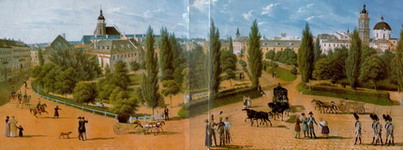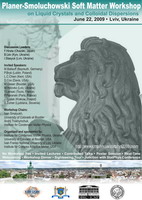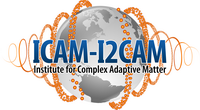PSSM Workshop on Liquid Crystals and Colloidal Dispersions
Nanophase segregation and frustration: spontaneous chirality and polarization splay in bent-core smectics
Yves Lansac2, Noel Clark1, and Matt Glaser1,
1 Department of Physics and Soft Materials Research Center,
University of Colorado, Boulder, CO 80309-0390, USA
2 LEMA, UMR 6157 CNRS-CEA, Université François Rabelais,
Parc de Grandmont, 37200 Tours, France
Abstract: A defining property of thermotropic smectic liquid crystals is nanophase segregation of chemically dissimilar functional groups into distinct sublayers, driven by intramolecular variations in flexibility, intermolecular interactions, or molecular shape. We argue that nanophase segregation is a unifying concept that can largely explain the polymorphism of calamitic and bent-core smectics. Specifically, nanophase segregation leads to frustration deriving from a mismatch in the preferred in-layer organization of distinct smectic sublayers. This built-in frustration can be relieved in a variety of ways. For example, frustration arising from competition between the conformational entropy of flexible aliphatic tails (favoring a relatively large area/molecule) and van der Waals attraction between rigid cores (favoring a smaller area/molecule) can be relieved by molecular tilt within the core sublayer. Similarly, frustration deriving from nanophase segregation may be responsible for nanostructure formation in bent-core smectics, including polarization splay in the B7 phase and spontaneous saddle-splay layer curvature in the dark conglomerate and B4 phases. Nanophase segregation also influences the structure and fluctuations of the interlayer interface, modifying tilt coupling (synclinic vs. anticlinic) and polar coupling (ferroelectric vs. antiferroelectric) between adjacent smectic layers.
We present results from coarse-grained and atomistic simulations of calamitic and bent-core liquid crystals aimed at characterizing nanophase segregation in smectics and exploring the molecular origins of tilt, spontaneous chirality, polarization splay, and saddle-splay layer curvature in bent-core liquid crystals. We find that minimal models incorporating excluded volume interactions and differential intramolecular flexibility display most of the commonly observed smectic phases, including smectic C and tilted hexatic phases of calamitic molecules, and spontaneously chiral and polarization splay modulated (B1 and B7) phases of bent-core molecules. Our findings suggest that thermotropic smectics can be understood as flexibility or shape amphiphiles, in strong analogy to lyotropic liquid crystals.















